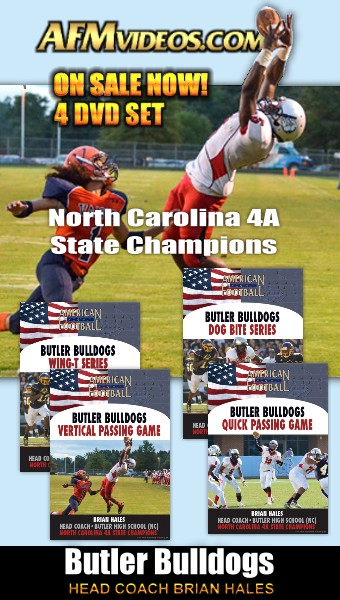- Home
- Subscribe
- Magazine
Current Issue
- Table of Contents
- Feature Article
- Subscribe
- X's & O's Vault
- Gridiron Store
- Help
- Contact Us
Sprint-Out Protection Scheme and Techniques
© August, 2011
by Ken Wilmesherr
Offensive Line Coach, Grossmont College
Sprint-out protection is used when the quarterback is breaking contain and sprinting out of the pocket to the left or the right. Depending on the defensive structure, sprint-out protection can be a man protection scheme to the call side and an area protection scheme to the backside.
It is important that linemen know and understand the launch point of the quarterback in the sprint-out protection scheme because the pocket will move. As the pocket moves, the offensive linemen must move and redirect their feet. Like any protection scheme, it is imperative your linemen understand the launch point because it will change the rushing angles of the defenders.
Call Side Guard and Tackle: If covered, the call side linemen (CSG and CST) will set to reach the call side gap, working to the call side defender protecting the inside gap. A lineman is considered covered when a defender is inside the framework of the offensive lineman on the line of scrimmage. If a call side lineman is uncovered, he will then soft post and pivot to the call side gap and dual read. The call side linemen will protect the call side gap if no one comes and they will than hinge with depth, moving the pocket.
The landmark for the call side offensive linemen is the outside armpit of the down defender. The call side offensive linemen will punch the outside armpit of the defender with his call side hand (the dominate hand, with the thumb up, called a thumb lift) controlling the defenders shoulder. The inside hand then will punch the middle of the defenders chest with the thumb up. It is important to maintain vertical and horizontal leverage as well as inside leverage while blocking the down defender.
If covered, the call side linemen are reaching the down defender and pinning him inside. The footwork is a first step slight (set to reach) bucket step, the second step is to the midline of the defender while the third step will bring the offensive linemen back to balance (to the proper base of support). Linemen need to understand their footwork will change depending on the alignment of the down defender to the call side.
If the call side linemen are uncovered, they will then soft post and pivot and dual read. The first step is a lateral pivot step (pick it up and put it down) with the call side foot. The second step is a drop step with the inside foot at a 45-degree angle. Dropping the inside foot allows the offensive linemen to turn their shoulders to the line of scrimmage and move the pocket with some depth.
Center: If the center is covered and if a defender is within the framework of his body, he will set to reach the defender to the call side. If he is uncovered and the defender is within the framework of his body, he then will soft post and pivot and dual read, eye balling the second-level defender and checking for a backside rusher. If he is blocking the backside rusher the center will do so with depth. The landmark and the punch are the same as the call side linemen.
Backside Guard: The backside guard will soft post and pivot protecting the inside gap if no one comes (hinge with depth). The uncovered lineman on the backside will dual read. A dual reader is an uncovered offensive lineman who is eyeballing a second-level defender and then works to a backside rusher. If the second level defender blitzes, the dual reader will block him. If not, he will check for a backside rusher with depth. The landmark and punch are the same as the call side linemen and center.
Backside Tackle: The backside tackle will kick at a 45-degree angle towards the launch point of the quarterback and block any threat inside out. An important coaching point is, if the backside tackle has any outside threat, he needs to run the defender getting width. This will disallow for any inside penetration by the defender. The backside tackle�s landmark and punch is determined by the path of the defender.
Running Back: The running back is responsible for the edge rusher. If there is a fire off the edge and a 5 tech, it is the responsibility of the call side tackle to alert the running back. He must make an alert call because the blocking assignments will change.
Coaching Points:
Running Backs Footwork and Blocking Assignment:
� Lead Step.
� Crossover Step.
� His aiming point is one yard outside of the end man on the line of scrimmage.
� An alert adjustment on the snap may be made because the end man on the line of scrimmage may change.
� Beware of an alert call for outside pressure (it is the responsibility of the call side tackle to alert the running back by making an alert call).
The Offensive Line Footwork:
CST to BSG
� Step to play side gap if covered (set to reach).
� If (uncovered) and no threat, hinge with depth and move the pocket.
BS T
� Kick out at a 45-degree angle toward the launch point of the QB.
� Block any penetration by working inside out.
� Force the defender to run around and not inside by gaining width.
About the author: Ken Wilmesherr is now in his sixth season as the offensive line coach at Grossmont College. He previously coached at Southwestern College and has 29 years of coaching experience on the high school and college level.
Sign Up for the Play of the Week Newsletter

OFFENSIVE LINE VIDEOS

MORE X's & O's


|
Home |
Magazine |
Back Issues |
Shopping |
Subscribe |
Contact
Girdiron Strategies PO Box 14041 North Palm Beach, FL 33408 p. 561-355-5068 Copyright 2024, Gridiron Strategies a division of AFM Media, LLC. All Rights Reserved. |

Subscribe
Login
Renew
Change Address
Customer service